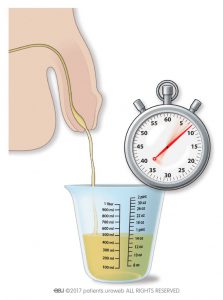Your doctor may ask you to keep a bladder diary. This can help diagnose urinary problems, including overactive bladder and benign prostatic enlargement. The bladder diary is important because it helps your doctor understand your symptoms better.
The bladder diary will note the number of times you urinated, the amount of urine passed, the pad weight if you are using pads, and times when you had incontinence or urgency. This is typically done over 24 hours and for 3 consecutive days to help identify the problem.
You can download a bladder diary here.
You will keep track of how much you drink, how often you go to the toilet to pass urine, and how much you produce by measuring the amount of urine at home with the help of a measuring jug. You may use a stopwatch to record the time it took you to urinate. Note down the amount of urine (in millilitres) and the time (in seconds) (Fig. 1).


